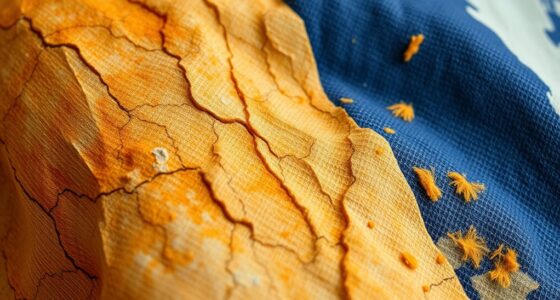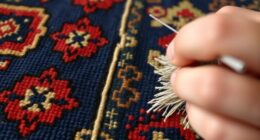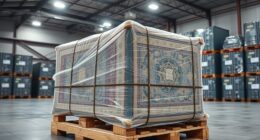To choose eco-dyed rugs, look for certification labels like GOTS, OEKO-TEX Standard 100, Green Label Plus, Fair Trade, or USDA Organic. These labels verify that the rugs use sustainable materials, eco-friendly dyes, and safe manufacturing practices, ensuring better indoor air quality and social responsibility. Focus on certifications that match your values and needs, and you’ll find options that are safer for your home and the environment. stay tuned for more insights.
Key Takeaways
- Look for certifications like GOTS, OEKO-TEX, and Green Label Plus to ensure eco-friendly dyes and safe manufacturing practices.
- Verify that the certification covers dye sourcing, chemical use, and indoor air quality for healthier home environments.
- Choose labels from reputable organizations that guarantee sustainable sourcing, fair labor, and non-toxic dyeing processes.
- Check certification validity periods and renewal requirements to ensure ongoing compliance with eco standards.
- Prioritize certified rugs that align with your eco-conscious values and promote transparency and ethical practices.
Understanding Eco-Friendly Certification Standards
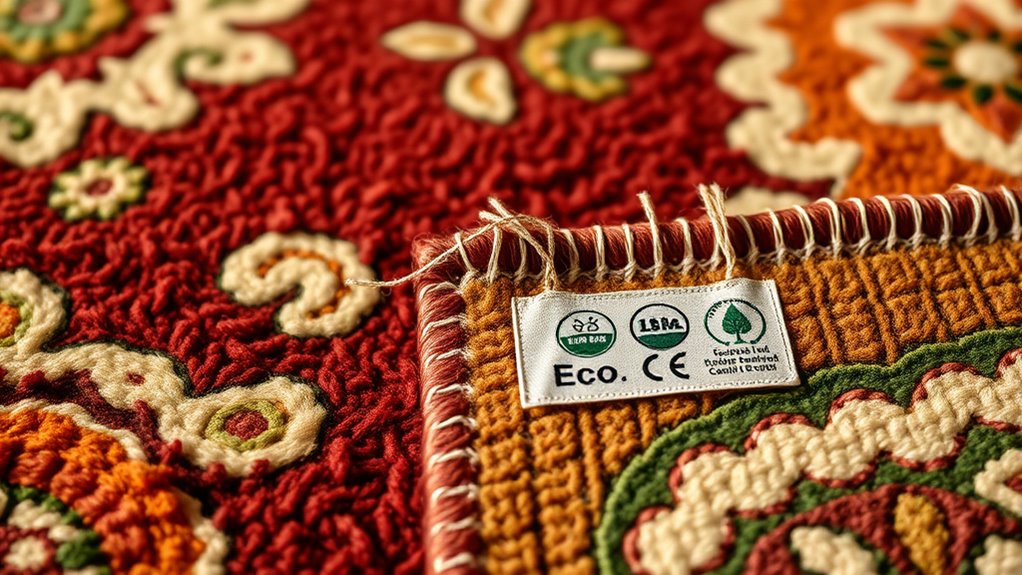
To choose truly eco-friendly rugs, it’s essential to understand the certification standards that verify their sustainability. Certifications like GOTS or OEKO-TEX ensure that rugs meet strict criteria for sustainable sourcing and eco conscious manufacturing. These standards confirm that fibers are responsibly harvested, minimizing environmental impact and avoiding harmful chemicals. When a rug is certified, you can trust that it’s made with environmentally friendly practices, supporting sustainable agriculture and reducing pollution. Certification labels provide transparency, giving you confidence that the rug’s production aligns with eco-friendly principles. By checking for these standards, you ensure your purchase promotes responsible sourcing and manufacturing, helping you select a truly eco-conscious rug that benefits both the environment and your home. Additionally, understanding the role of attention in sustainable practices can help you become a more conscious consumer. Recognizing certification labels can further aid in making informed choices about eco-friendly products.
The Significance of GOTS Certification
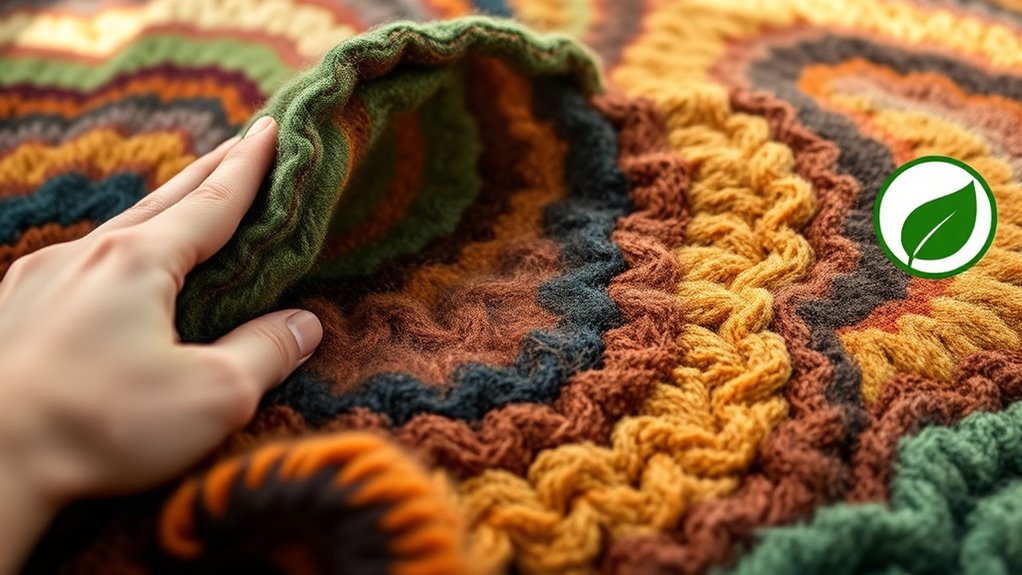
When you see GOTS certification on a rug, you’re assured it meets strict organic standards. It also shows the company follows ethical practices and prioritizes fair labor. Most importantly, it guarantees the product is safe for your home and the environment. Additionally, certification processes often incorporate data privacy considerations to ensure transparency and trustworthiness in labeling. Understanding the horsepower of electric dirt bikes can further inform your choices, especially when considering the performance and safety of eco-friendly products. Being aware of currency fluctuations can further inform your purchasing decisions, especially when dealing with international suppliers.
Ensures Organic Standards
GOTS certification plays a crucial role in guaranteeing that eco-dyed rugs meet strict organic standards. It guarantees that rugs are made with sustainable sourcing and eco-friendly dyes, minimizing environmental impact. When a rug bears this certification, you can trust that every step—from fiber production to dye application—adheres to rigorous organic criteria. This includes avoiding harmful chemicals and promoting eco-conscious manufacturing. Studies show that eco-friendly processes lead to better health outcomes for workers and consumers alike. Supporting sustainable practices throughout the supply chain supports the broader goal of reducing environmental footprints. Choosing GOTS-certified rugs means you’re committing to products that prioritize health, environmental sustainability, and ethical standards. This certification assures you that your eco-dyed rug aligns with genuine organic principles.
Promotes Ethical Practices
GOTS certification not only guarantees environmental sustainability but also guarantees that ethical practices are upheld throughout the manufacturing process. It ensures that artisans and workers receive fair wages and work under safe conditions, promoting ethical labor. Additionally, GOTS emphasizes sustainable sourcing, meaning raw materials are responsibly harvested without harming communities or ecosystems. By choosing GOTS‑certified rugs, you support brands committed to social responsibility and transparency. This certification encourages manufacturers to prioritize fair treatment and ethical standards from field to finished product. Studies indicate that GOTS certification has a positive impact on ethical practices and promotes responsible supply chains.
Guarantees Product Safety
Ensuring product safety is a key benefit of choosing eco-dyed rugs with GOTS certification. This certification guarantees that the rug’s materials come from sustainable sourcing, reducing the risk of harmful chemicals. The eco label significance lies in its strict standards, which prioritize non-toxic dyes and safe manufacturing processes. When you select a GOTS-certified rug, you can trust it’s free from hazardous substances that could affect your health or the environment. This reassurance is especially important if you have children or allergies. Additionally, understanding certification labels can help individuals stay informed about health screening options, emphasizing the importance of safe practices and early detection.
What Does OEKO-TEX Standard 100 Guarantee?
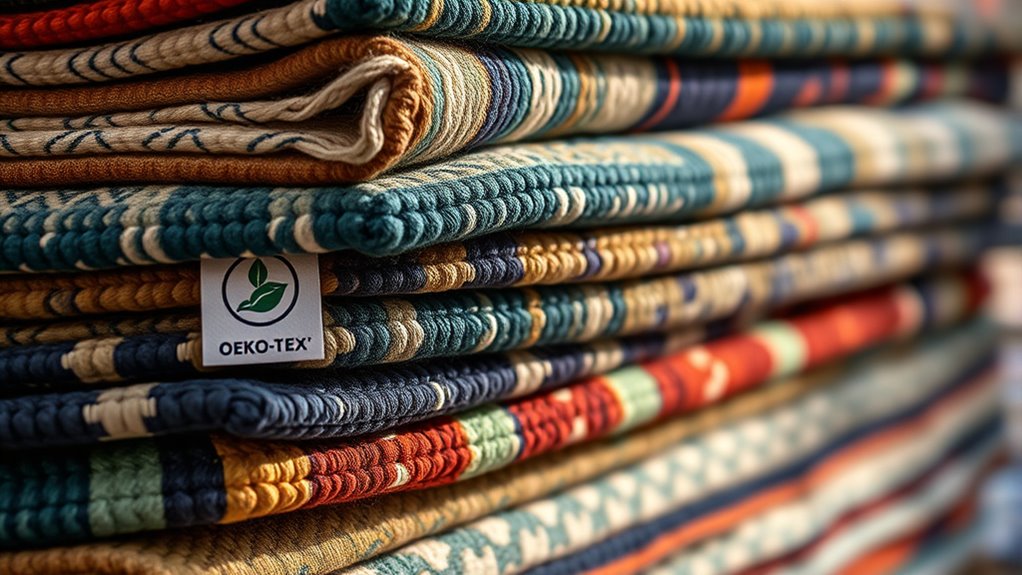
The OEKO-TEX Standard 100 guarantees that eco-dyed rugs have been tested and certified for harmful substances, ensuring they are safe for your home and health. This eco label signifies that the rug’s dyes, including natural dyes, meet strict safety criteria, reducing risks of allergic reactions or chemical exposure. When choosing a rug with this certification, you know it’s been thoroughly evaluated for substances that could affect your well-being. The standard emphasizes safety and environmental responsibility, making it a reliable indicator of quality. Here’s a quick overview:
| Certification Aspect | What It Means |
|---|---|
| Harmful Substance Testing | No harmful chemicals or toxins present |
| Natural Dyes & Eco Label Significance | Uses eco-friendly, natural dyes with certification proof |
| Safety for Home & Health | Safe for sensitive individuals and households |
Additionally, understanding the textile line involved in production can help ensure the overall quality and sustainability of the rug. Incorporating eco-friendly materials into the manufacturing process further enhances the environmental benefits of certified rugs. Moreover, adhering to recognized standards like safety testing protocols can provide added assurance of product safety and environmental impact. Recognizing the importance of certification standards helps consumers make more informed and responsible choices.
The Role of Green Label Plus in Eco-Design
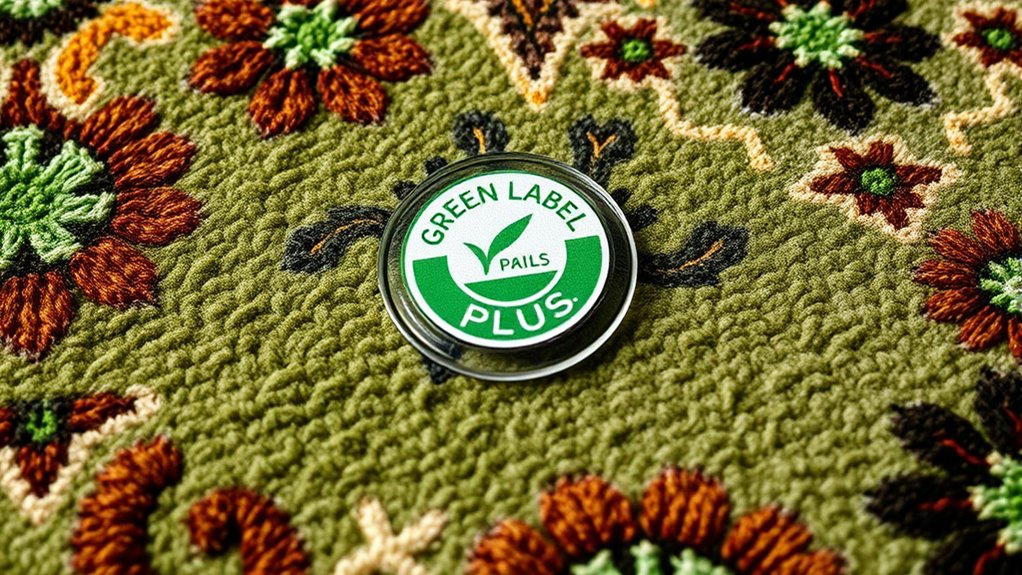
Green Label Plus sets strict certification standards that guarantee rugs are healthier for your indoor environment. By choosing products with this label, you support eco-friendly manufacturing practices that improve indoor air quality. It’s a key step in making your home more sustainable and safe. Additionally, selecting products with recognized certification labels helps ensure transparency and adherence to environmental standards. These labels often reflect a commitment to sustainable manufacturing practices, further promoting eco-conscious choices. Incorporating eco-friendly certifications can also guide consumers toward products that meet rigorous environmental and health criteria. Utilizing certified products contributes to reducing indoor pollutants and supports overall environmental health.
Certification Standards Overview
Have you ever wondered how eco-friendly rugs are verified? Certification standards like Green Label Plus help guarantee rugs meet strict environmental criteria. This label emphasizes safe textile dyeing processes, reducing harmful chemical use, especially in natural fibers. It also assesses indoor air quality, confirming that carpets don’t emit pollutants. Additionally, ethical hacking principles highlight the importance of ongoing testing and verification to maintain certification integrity. Ensuring compliance with these standards involves regular indoor air quality assessments and transparent reporting. Moreover, implementing self-monitoring practices is essential for continuous compliance and sustainability. Maintaining these rigorous standards also requires consistent manufacturer audits to ensure ongoing adherence to eco-design principles. Key points include:
- The importance of strict textile dyeing standards for eco-rugs
- Focus on natural fibers to reduce environmental impact
- Ongoing testing to maintain certification integrity
Green Label Plus plays a crucial role in eco-design by setting rigorous benchmarks, making sure your rug’s eco-friendly claims hold true. It gives you confidence that the product aligns with sustainable practices and supports healthier indoor environments.
Indoor Air Quality Benefits
Certification standards like Green Label Plus not only guarantee rugs meet environmental benchmarks but also play a vital role in improving indoor air quality. By setting limits on chemical emissions, these standards help reduce harmful indoor air pollutants that can linger from manufacturing processes. When you choose a rug with Green Label Plus certification, you’re ensuring that it emits fewer volatile organic compounds (VOCs), leading to healthier indoor air. This means less irritation for allergy sufferers and a safer environment overall. Reduced chemical emissions translate to cleaner indoor air, helping you breathe easier daily. These standards prioritize occupant health by minimizing airborne toxins. As a result, certified rugs contribute to a safer, more comfortable living space, making your home a healthier environment for everyone inside.
Eco-Friendly Manufacturing Practices
Eco-friendly manufacturing practices are essential in creating rugs that support sustainability and reduce environmental impact. By prioritizing natural dyes, you limit the use of harmful chemicals while achieving vibrant, long-lasting colors. Ethical sourcing ensures that materials come from suppliers who respect fair labor practices and environmentally responsible methods. Green Label Plus certification highlights companies committed to reducing volatile organic compounds (VOCs) and implementing eco-conscious processes.
Key aspects include:
- Using natural dyes instead of synthetic chemicals
- Ensuring ethical sourcing of raw materials
- Adopting sustainable production techniques
These practices help minimize pollution, conserve resources, and promote social responsibility. When choosing eco-dyed rugs, look for brands that embrace eco-friendly manufacturing to support a healthier planet and safer indoor environments.
Recognizing Fair Trade Certified Rugs

How can you tell if a rug is Fair Trade Certified? Look for a certification label or logo from a recognized organization, which indicates the rug meets strict fair trade standards. Fair trade certification guarantees that the artisans and workers involved receive fair wages and work under safe conditions, reflecting a strong commitment to social responsibility. These labels also confirm that the materials are sourced ethically and that the production process minimizes environmental impact. When shopping, ask vendors about the certification and check for reputable seals, such as those from Fair Trade USA or other trusted agencies. Recognizing Fair Trade Certified rugs empowers you to support ethical practices, promote social responsibility, and help improve the lives of artisans around the world.
The Importance of USDA Organic Certification

Building on your awareness of fair trade standards, understanding USDA Organic certification adds another layer of assurance about the rugs you choose. It guarantees sustainable sourcing practices, meaning fibers are grown without harmful chemicals and with eco-friendly methods. This certification also emphasizes dye durability, so the colors stay vibrant longer, reducing the need for frequent replacements. When shopping, look for these benefits:
- Organic fibers that support environmentally friendly farming
- Eco-conscious dyeing processes that minimize chemical use
- Long-lasting colors for sustained aesthetic appeal
USDA Organic certification confirms that the rug’s materials and dyes meet strict standards, giving you confidence in its environmental impact and durability. It’s an essential marker for eco-conscious consumers who want sustainable, high-quality rugs that last.
How to Identify Eco-Dyed Rugs With Environmental Labels

When shopping for eco-dyed rugs, paying attention to environmental labels can help you make informed choices. Look for labels that specify the use of natural dyes, which indicate the rug’s colors come from plant-based or mineral sources rather than synthetic chemicals. These labels often highlight the dyeing process’s eco-friendly nature. Additionally, check for certifications that mention colorfastness, ensuring the rug’s vibrant hues won’t fade quickly with washing or exposure to sunlight. Labels like GOTS or OEKO-TEX may also verify eco-friendly practices and natural dye use. By recognizing these labels, you ensure your rug is genuinely eco-dyed, with colors derived from natural sources and maintained through environmentally responsible methods. This helps you select sustainable, safe, and long-lasting rugs for your space.
Interpreting the Responsible Wool Standard (RWS)

Interpreting the Responsible Wool Standard (RWS) helps you verify that the wool used in your rug comes from farms committed to animal welfare and sustainable practices. RWS certification emphasizes wool transparency, ensuring you know the fiber’s origin and production methods. When evaluating RWS labels, look for clear farm traceability and adherence to ethical standards. This standard promotes the use of sustainable fiber, reducing environmental impact and supporting responsible farming.
Key points to contemplate include:
- Confirmation of farm-level animal welfare practices
- Traceability from farm to finished product
- Commitment to environmental sustainability
Comparing Certification Labels for Informed Choices
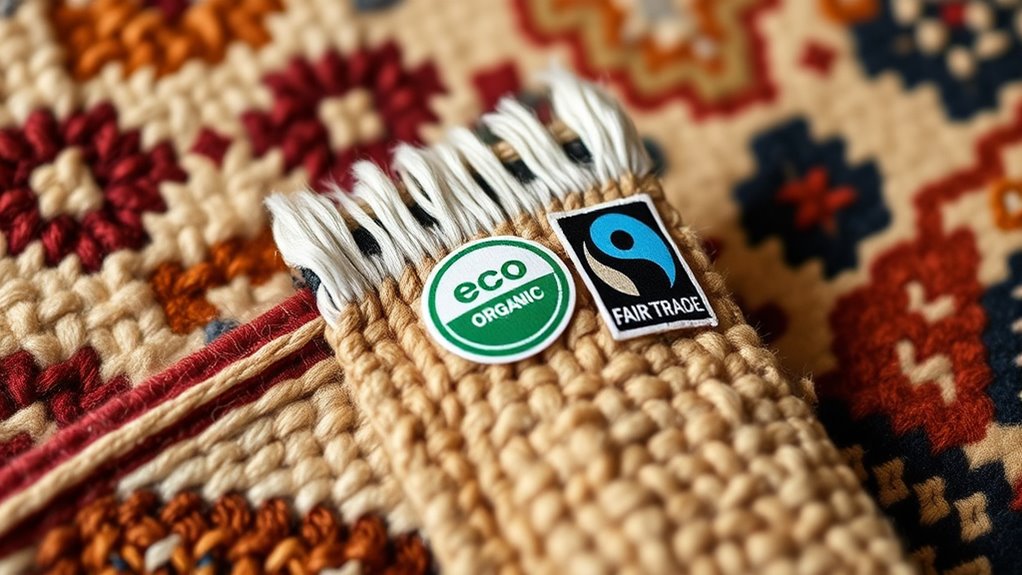
Comparing certification labels helps you make confident, eco-conscious choices when selecting rugs. Look for labels that verify the use of natural dyes, which are less harmful to the environment and safer for indoor air quality. These certifications often emphasize dye fixation processes that ensure color longevity without synthetic chemicals, reducing water and energy use. For example, some labels specify standards for natural dye sourcing and environmentally friendly dye fixation techniques. By understanding these distinctions, you can select rugs that align with your values of sustainability and health. Pay attention to certification details that confirm eco-friendly practices, such as minimal chemical use and responsible dyeing methods. This comparison empowers you to choose rugs that are both beautiful and environmentally responsible.
Frequently Asked Questions
Are Eco-Dyed Rugs More Durable Than Traditionally Dyed Rugs?
You might wonder if eco-dyed rugs last longer than traditional ones. Generally, eco-dyed rugs are just as durable because they use high-quality dyes with good dye stability, which helps the colors stay vibrant over time. Fiber longevity also plays a role, and eco-friendly methods don’t compromise it. So, with proper care, eco-dyed rugs can be equally durable, offering both beauty and longevity in your space.
Can Certification Labels Guarantee That a Rug Is Completely Eco-Friendly?
Certainty about certification labels can be tricky, as they’tell tales of certification authenticity and label credibility. While labels aim to guarantee eco-friendliness, they can’t promise complete cleanliness, since standards vary and false claims exist. You should scrutinize certifications, research standards, and trust transparent brands. Remember, labels are helpful hints, but diligent due diligence ensures you’re truly choosing eco-friendly rugs, rather than just trusting labels blindly.
How Do Eco-Certifications Impact the Pricing of Rugs?
Eco-certifications often lead to a pricing premium because they signal higher standards, which can influence your perception of quality and sustainability. When you see a rug with eco-labels, you might expect to pay more, as these certifications often mean environmentally friendly materials and ethical production. This consumer perception can drive up costs, but it also assures you that you’re supporting sustainable practices, making the extra expense worthwhile.
Are There Regional Differences in Eco-Label Standards for Rugs?
Imagine eco-label standards as a patchwork quilt, each region stitching its own rules. You’ll find regional standards vary, with some labels shining brighter in certain areas, ensuring label consistency for eco-friendly rugs. This means you might notice differences in certification rigor depending on where you shop. Being aware of these regional nuances helps you make confident choices, knowing what’s behind each label’s promise of sustainability.
How Often Should Eco-Certifications Be Renewed or Verified?
You should check the certification renewal and verification frequency regularly, usually annually or as specified by the certifying organization. Staying updated guarantees your eco-friendly rug truly meets sustainability standards. Manufacturers often renew certifications periodically, and verification processes may include on-site inspections or document reviews. By keeping track of renewal dates, you ensure your rug remains compliant and eco-certified, giving you confidence in its environmental credentials.
Conclusion
By understanding these eco-certification labels, you can confidently select rugs that breathe life into your space without harming the planet. Picture walking barefoot on a lush, sun-dappled meadow or draping your home in warmth and sustainability. Each label guides you toward rugs woven with care, ensuring your choices nurture the environment and support fair labor practices. Choose wisely, and let your home become a sanctuary of beauty and eco-consciousness.




